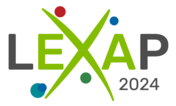Speaker
Description
According to the fundamental symmetries that underpin the Standard Model, both matter and antimatter should have been produced in equal quantities at the Big Bang. The absence of antimatter in our Universe as we observe it today, strongly motivates direct matter-antimatter comparisons, where any observed difference would lead to new physics. The Antihydrogen Laser Physics Apparatus (ALPHA) collaboration at CERN produces and traps antihydrogen atoms by combining antiproton and positron plasmas, which are subsequently used for precise studies. Recent progress includes the accumulation of thousands of atoms, direct laser cooling of the antihydrogen sample [1] and the first observation of the motion of antihydrogen in a gravitational field [2].
Laser spectroscopy of antihydrogen has already resulted in a test of CPT symmetry to a relative precision of 2 × 10−12 [4]. In hydrogen however, the same spectral feature, the 1S-2S transition, has been determined up to a precision of 4 × 10−15 [5]. To enable matter-antimatter comparisons at that level, we have implemented a Cs fountain clock in collaboration with NPL [3]. The fountain acts as a local absolute frequency reference
and is used to steer an active hydrogen maser in the same laboratory. In addition to comparing the frequency of the maser with our fountain, we also cross-check against national metrology labs via satellite frequency transfers. A frequency comb and a stabilized fiber link, as well as two ultra-low expansion cavities, then allow for accurate determination of the laser frequency that is experienced by the antihydrogen atoms.
I will present recent progress and the current status towards a more precise comparison of the 1S2S transition in hydrogen and antihydrogen. I will also detail how we plan to access fundamental quantities, such as the Rydberg constant in an antimatter system and the antiproton radius, by carrying out laser spectroscopy on higher-lying excited states in antihydrogen.
References
[1] C. J. Baker et al., Nature 592, 35 (2021)
[2] E. Anderson et al., Nature 716, 621 (2023)
[3] R. J. Hendricks, F. Ozimek, K. Szymaniec, B. Nag´orny, P. Dunst, J. Nawrocki, S. Beattie, B. Jian, and K. Gibble, IEEE Trans. Ultrason. 66 624 (2019)
[4] M. B. Ahmadi et al., Nature 557 71 (2018)
[5] C. G. Parthey, A Matveev, J. Alnis, B. Bernhardt, A. Beyer, R. Holzwarth, A. Maistrou, R. Pohl, K. Predehl, T. Udem, T. Wilken, N. Kolachevsky, M. Abgrall, D. Rovera, C. Salomon, P. Laurent, and T. W. Haensch Phys. Rev. Lett. 107 20 (2011)

